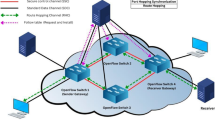Abstract
Mobile Opportunistic Networks (MONs) use the store-carry-and-forward scheme to transmit packets, so as to deal with the intermittently connected links. This new communication paradigm makes them very different from the traditional multi-hop wireless networks. To improve the delivery performance, some smart forwarding schemes have been proposed by injecting multiple copies of packets into the temporal network. Unfortunately, these schemes allocate data copies following the aggregate contact information, i.e., information obtained by considering the samples from all pairs. They ignore the individual contact feature of nodes. We show that the aggregate contact can be very different from the contact of individual pairs, therefore, using the former to guide copy allocation is not correct in general, although it works well in some cases. In this paper, we propose OPPO, an optimal copy allocation scheme in MONs. OPPO exploits the transient contact ratio of nodes to spray data copies. Theoretical analysis proves that OPPO achieves the optimal delivery delay, and experimental results verify it simultaneously improves the packet delivery ratio compared to the SprayWait and HS, two state-of-the-art works.







Similar content being viewed by others
Notes
The contact ratio of a node is the number of contacts between itself and others in one time slot.
When two nodes have a contact, they first swap their contact ratios.
Note that Hug uses the similar forwarding scheme as HS (please refer to the introduction section), the aforementioned condition is also fit for Hug.
Note that CMM is used in PROPHET, Hug and HS, so as to make a fair comparison, we here use the CMM to simulate nodes’ movement patterns.
References
Yuan P, Liu P (2015) Data fusion prolongs the lifetime of mobile sensing networks. J Netw Comput Appl 49:51–59
Hass ZJ, Small T (2006) A new networking model for biological applications of ad hoc sensor networks. IEEE/ACM Trans Netw 14(1):27–40
Xie K, Wang X, Wen J, et al. (2015) Cooperative routing with relay assignment in multiradio multihop wireless networks. IEEE/ACM Trans Netw:1–14
Xie K, Wang L, Wang X, et al. (2015) Sequential and adaptive sampling for matrix completion in network monitoring systems. In: Proceedings of IEEE Infocom, pp 2443–2451
Ma H, Zhao D, Yuan P (2014) Opportunities in mobile crowd sensing. IEEE Commun Mag 52(8):29–35
Li ZT, Chen Q, Zhu GM, et al. (2015) A low latency, energy efficient MAC protocol for wireless sensor networks. Int J Distrib Sensor Netw 6:1–9
Dong M, Ota K, Liu A, et al. (2016) Joint optimization of lifetime and transport delay under reliability constraint wireless sensor networks. IEEE Trans Parallel Distrib Syst 27(1):225–236
Pentland A, Fletcher R, Hasson A (2004) Daknet: Rethinking connectivity in developing nations. Computer 37(1):78–83
Pei T, Deng Y, Li Z, et al. (2016) A throughput aware with collision-free MAC for wireless LANs. Sciece China Inf Sci 59(2):1–3
Xie K, Wang X, Liu X, et al. (2015) Interference-aware Cooperative Communication in Multi-radio Multi-channel Wireless Networks. IEEE Trans Comput:1–1
Zhao D, Ma H, Liu L, et al. (2013) On opportunistic coverage for urban sensing. In: Proceedings of IEEE MASS, pp 231–239
Xiao F, Xie X, Jiang Z, et al. (2015) Utility-aware data transmission scheme for delay tolerant networks. Peer-to-Peer Netw Appl:1–9
Liu X, Dong M, Ota K, Hung P, Liu A (2016) Service pricing decision in Cyber-Physical systems: Insights from game theory. IEEE Trans Serv Comput 9(2):186–198
Lindgren A, Doria A, Schelen O (2004) Probabilistic routing in intermittently connected networks. Lect Notes Comput Sci 3126:239–254
Hui P, Crowcroft J, Yoneki E (2008) Bubble rap: Social based forwarding in delay tolerant networks. In: Proceedings ACM Mobihoc, pp 241–250
Chen K, Shen HY (2012) SMART: Lightweight Distributed social map based routing in delay tolerant networks. In: Proceedings IEEE ICNP, pp 1–10
Yuan P, Ma H, Fu H (2015) Hotspot-entropy based data forwarding in opportunistic social networks. Pervasive Mob Comput 16:136–154
Spyropoulos T, Psounis K, Raghavendra CS (2008) Efficient routing in intermittently connected mobile networks: The Multiple-Copy case. IEEE/ACM Trans Netw 16(1):77–90
Derakhshanfard N, Sabaei M, Rahmani M (2015) Sharing spray and wait routing algorithm in opportunistic networks. Wireless Networks:1–12
Ababou M, Elkouch R, Bellafkih M (2014) New strategy to optimize the performance of spray and wait routing protocol. Int J Wirel Mob Netw 6(2):47
Wang G, Lu H, Xu L (2009) Nested spray and wait routing algorithm based on core nodes assisted. In: Proceedings IEEE ciSE, pp 1–4
Kim H, Nam C, Choi I (2014) Probability-based spray and wait protocol in Delay Tolerant Networks. In: Proceedings IEEE ICOIN, pp 412–416
Yuan P, Ma H (2012) Hug: Human gathering point based routing for opportunistic networks. In: Proceedings IEEE WCNC, pp 3024–3029
Wu J, Xiao M, Huang L (2013) Homing spread: community home-based multi-copy routing in mobile social networks. In: Proceedings IEEE INFOCOM, pp 2319–2327
Ibrahim M, Nain P, Carreras I (2009) Analysis of relay protocols for throwbox-equipped dtns. In: Proceedings IEEE wiOPT, pp 1–9
Passarella A, Conti M (2013) Analysis of individual pair and aggregate intercontact times in heterogeneous opportunistic networks. IEEE Trans Mob Comput 12(12):2483–2495
Acknowledgments
We acknowledge the support of the National Natural Science Foundation of China under Grant No. U1404602, the Young Scholar Program of Henan Province under Grant No. 2015GGJS-086 and the Dr. Startup Project of Henan Normal University under Grant No. qd14136. We also wish to thank the reviewers for their valuable comments.
Author information
Authors and Affiliations
Corresponding author
Rights and permissions
About this article
Cite this article
Yuan, P., Wang, C. OPPO: An optimal copy allocation scheme in mobile opportunistic networks. Peer-to-Peer Netw. Appl. 11, 102–109 (2018). https://doi.org/10.1007/s12083-016-0472-1
Received:
Accepted:
Published:
Issue Date:
DOI: https://doi.org/10.1007/s12083-016-0472-1




